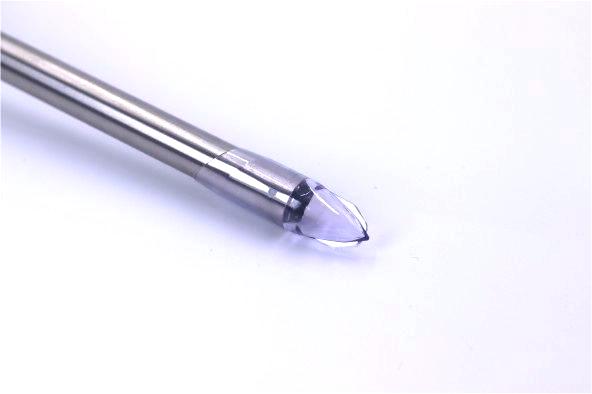

What are the key points of structural characterization of the puncture tip of a trocar puncture device?
I. Structural Characteristics
The trocar puncture site is the core part of the perforator, and its design directly affects the smoothness of the puncture and the safety of the patient. The main structural features include:
1. Tapered puncture head
· Shape design: the puncture head is usually conical, cone-column combination or tip with a blade, the specific shape affects the puncture resistance and trauma size.
· Tapered heads reduce puncture resistance and are suitable for a variety of tissue layers.
· A bladed tip cuts tissue more easily, but needs to be tightly controlled to avoid excessive damage.
· Tip angle: the tip angle usually ranges from 10°-30°; too sharp increases the risk of tissue damage, and too blunt makes puncture more difficult.

2. Trocar body
· Surface characteristics: The outer wall of the trocar is usually coated with a low-friction coating to reduce friction during puncture and to protect the tissue.
· Inner wall design: The inner wall needs to be smooth to facilitate the passage of instruments, but it is important to avoid over-smoothing to minimize sealing performance.
3. Sealing mechanism
· Check valve design: At the proximal end of the trocar, a check valve is usually provided to prevent gas leakage. The sealing mechanism should match the inner diameter of the cannula and the diameter of the insertion device.
· Decompression function: some designs will add decompression rings or anti-slip devices to reduce the pressure on the patient's abdomen.
Second, process points
Precision and consistency in the manufacturing process are fundamental to ensuring the performance of the applicator. Key processes include the following:
1. Tip machining process
· Precision Grinding: The piercing tip's directly determines the piercing performance. The use of CNC grinding equipment for the mold cavities ensures the consistency of the tip angle.
· Polishing Process: The tip needs to be micro-polished to reduce the presence of tiny burrs and reduce tissue damage.
· Cutting Edge Treatment: If the design includes a cutting edge, laser cutting technology is used to ensure the sharpness and durability of the edge.

2. Coating process
· Low friction coatings: Sleeves are typically coated with polytetrafluoroethylene (PTFE) or silicone, which should be uniformly coated to a thickness of 5-20 microns.
· antimicrobial coating: some products will add antimicrobial coating, need to ensure that the coating is still effective after sterilization.
3. Injection molding process
· Mold precision: casing and other plastic parts are usually injection molded using high-precision molds, mold tolerances need to be controlled within ± 0.01mm.
· Dust-free production: All processing should be completed in a clean room in accordance with ISO 13485 to prevent particulate contamination.
4. Assembly and Inspection
· Assembly Precision: Seals and sleeves should be assembled with automated equipment to avoid manual errors.
· Performance test: puncture resistance, sealing performance and torsional strength test should be carried out before delivery to ensure the batch quality consistency.
Third, Material selection
The choice of material for the trocar puncture device is critical to its performance, safety and cost.

1. Tip material
· Metal Tip: Typically high hardness stainless steel (e.g. 316L or 440C) is used for good corrosion resistance and strength.
· Plated tips: To enhance biocompatibility, tips may be titanium plated or coated with ceramics.
2. Trocar materials
· Medical grade plastics: Tubing is mostly made of polycarbonate (PC) or polypropylene (PP) for both strength and toughness. For cryogenic plasma sterilization compatibility, polysulfone (PSU) or polyetherimide (PEI) may be used.
· reinforcing materials: to improve rigidity, some designs will incorporate glass fiber or carbon fiber reinforcing materials.
3. Seal materials
· Silicone Rubber: Seals are mostly made of medical grade silicone rubber, which has excellent elasticity and air tightness.
· thermoplastic elastomer: provide higher abrasion resistance and tear resistance, commonly used in dynamic sealing structure.
Fourth, the core points of the puncture performance guarantee
1. Balance of tip sharpness and durability: Optimize tip design and material selection to ensure smooth initial puncture and reduce the risk of bluntness for multiple punctures.
2. Minimizing friction: Optimizing the coating and design of the outer wall of the cannula to make the puncture process easy and smooth.
3. Sealing and Pressure Relief Coexist: Ensure that gas seal is maintained under different situations of insertion or removal of operating instruments.
4. Batch Stability: Strict quality control system ensures that each product meets the design specifications.
Through DONHO's comprehensive optimization of structure, process and materials, the disposable cannula puncture device is able to provide reliable performance in clinical applications, safeguarding patient safety while enhancing the surgeon's experience. These features, together with the process elements, determine the market competitiveness and clinical value of the product.
+86 18361958211
marketing@cndonho.com
+86 18361958211
No.2 Zhiwei Road, Qiandeng Town, Kunshan City, Jiangsu Province, China




